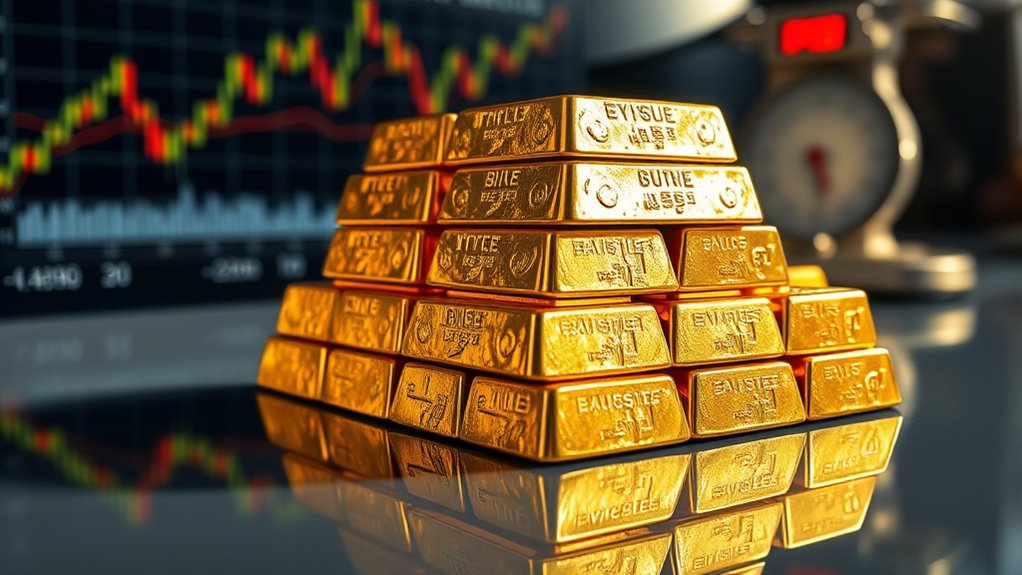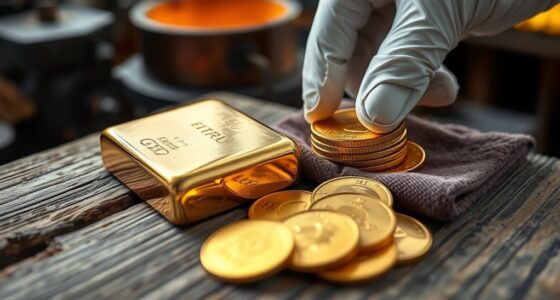Gold is priced mainly based on its spot price, which reflects the current market value for immediate delivery, often quoted in US dollars per ounce. This price is influenced by supply and demand, economic conditions, currency values, and global factors like geopolitical risks. Futures, ETFs, and mining stocks also mirror these changes. To understand how these elements interact and impact prices, explore further, and you’ll gain a clearer picture of setting your investment or trading strategies.

Understanding gold pricing is essential for anyone looking to invest or trade in gold. The price you see quoted usually refers to the spot price, which is the cost for immediate delivery of gold. This spot price acts as a benchmark and is influenced by various factors, including the London Bullion Market Association (LBMA) Gold Price, a global standard used by traders worldwide. Gold prices are typically quoted per ounce in US dollars, making it easier to compare across markets. However, keep in mind that prices can fluctuate slightly between different regional markets due to local supply and demand conditions, taxes, or currency differences. When you buy or sell gold, you’re often dealing with the spot price, but there are also other instruments like futures contracts, which set a price for gold to be delivered at a future date. These futures can influence spot prices through hedging and speculation, as traders lock in prices to protect themselves against future market movements.
Gold prices are primarily based on the spot price, influenced by global standards like LBMA and regional market factors.
In addition to the spot price, various market instruments impact gold pricing. For example, gold futures contracts are agreements to buy or sell gold at a predetermined price on a specific future date. These are primarily used by traders seeking to hedge risks or speculate on price movements. Gold CFDs, or contracts for difference, let you speculate on price changes without owning the physical gold. Gold ETFs, or exchange-traded funds, track the gold price and provide exposure without the hassle of storage. Shares in gold mining companies also play a role, as their stock prices often move in tandem with gold prices, reflecting market expectations and production costs.
Several key factors influence gold prices. Economic uncertainty or recession fears often drive demand for gold as a safe haven, causing prices to rise. High inflation levels also support higher gold prices because investors see gold as a protection against currency devaluation. Conversely, when interest rates go up, gold prices tend to drop due to increased opportunity costs, as higher rates make other investments more attractive. The strength of the US dollar affects gold as well; a weaker dollar makes gold cheaper for holders of other currencies, boosting demand and prices. Geopolitical issues like conflicts or political instability tend to push gold prices higher because they increase market uncertainty and demand for safe assets. Market speculation can also cause short-term fluctuations in gold prices, as traders react to news and sentiment.
Understanding these dynamics helps you better grasp how gold prices are formed and how to navigate trading or investing strategies. Recognizing support and resistance levels, for instance, can help you time your buy or sell decisions effectively. As a beginner, it’s important to determine your goals—whether for hedging inflation, diversification, or short-term trading—and choose the appropriate investment method accordingly. Always buy from reputable sources and monitor your holdings regularly to stay aligned with your financial objectives. Being aware of costs and risks, such as storage fees or price volatility, ensures you’re making informed decisions in the complex world of gold pricing.
Frequently Asked Questions
How Does Currency Inflation Affect Gold Prices?
Currency inflation generally pushes gold prices higher because it devalues paper money, making tangible assets more appealing. When inflation rises, you’ll notice investors flock to gold as a safe haven, boosting demand and prices. Gold’s limited supply and intrinsic value help it preserve worth better than currency. So, as inflation erodes currency value, you’ll likely see gold become more attractive and its price increase accordingly.
What Role Do Geopolitical Events Play in Gold Valuation?
You see, geopolitical events play a significant role in gold valuation because they create uncertainty and risk in the market. When tensions rise—like trade wars, regional conflicts, or diplomatic disputes—investors turn to gold as a safe haven. This increased demand drives up gold prices, especially during short-term crises. Over time, persistent geopolitical risks can sustain higher gold prices, reflecting investors’ desire for stability amid global instability.
Can Gold Prices Be Manipulated by Large Investors?
Imagine trying to steer a boat through choppy waters—large investors can sway gold prices similarly. They use tactics like spoofing or short selling to create false demand, much like stirring waves to influence direction. For example, JPMorgan paid $920 million to settle manipulation charges. Your awareness of their influence helps you understand that, yes, big investors can manipulate gold prices, especially when they control significant market moves.
How Do Seasonal Trends Influence Gold Pricing?
Seasonal trends substantially influence gold pricing by creating predictable patterns throughout the year. You’ll notice prices tend to stay steady from January to July, then surge in the second half, especially around holidays like Diwali and Chinese New Year. These seasonal increases are driven by cultural demand and investor activity. By understanding these cycles, you can better time your investments, buying during low-demand periods and selling when seasonal rallies peak.
What Are the Differences Between Spot and Futures Gold Prices?
You should understand that spot gold prices reflect the immediate market value for gold you can buy or sell right now, while futures prices are agreements to buy or sell gold at a future date, factoring in storage, interest, and market expectations. Spot prices fluctuate throughout the day based on supply and demand, whereas futures prices include additional costs and reflect anticipated market conditions, offering different risk and leverage opportunities.
Conclusion
Now that you have a clearer picture of how gold is priced, you’re better equipped to navigate its shimmering world. Remember, understanding these subtle nuances can help you make more confident decisions and avoid hidden pitfalls. Gold’s true value lies in its timeless allure and the stories it whispers. Keep your curiosity alive, stay informed, and let the gleam of knowledge guide your way toward smarter investments. After all, a well-timed move can turn a shimmer into lasting treasure.









